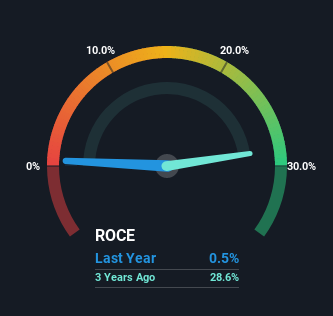Viaplay Group (STO:VPLAY B) May Have Issues Allocating Its Capital

To find a multi-bagger stock, what are the underlying trends we should look for in a business? Typically, we'll want to notice a trend of growing return on capital employed (ROCE) and alongside that, an expanding base of capital employed. Put simply, these types of businesses are compounding machines, meaning they are continually reinvesting their earnings at ever-higher rates of return. Although, when we looked at Viaplay Group (STO:VPLAY B), it didn't seem to tick all of these boxes.
Understanding Return On Capital Employed (ROCE)
Just to clarify if you're unsure, ROCE is a metric for evaluating how much pre-tax income (in percentage terms) a company earns on the capital invested in its business. Analysts use this formula to calculate it for Viaplay Group:
Return on Capital Employed = Earnings Before Interest and Tax (EBIT) ÷ (Total Assets - Current Liabilities)
0.0048 = kr64m ÷ (kr21b - kr7.5b) (Based on the trailing twelve months to September 2022).
So, Viaplay Group has an ROCE of 0.5%. In absolute terms, that's a low return and it also under-performs the Media industry average of 9.6%.
See our latest analysis for Viaplay Group

Above you can see how the current ROCE for Viaplay Group compares to its prior returns on capital, but there's only so much you can tell from the past. If you're interested, you can view the analysts predictions in our free report on analyst forecasts for the company.
What Can We Tell From Viaplay Group's ROCE Trend?
In terms of Viaplay Group's historical ROCE movements, the trend isn't fantastic. Around five years ago the returns on capital were 48%, but since then they've fallen to 0.5%. However, given capital employed and revenue have both increased it appears that the business is currently pursuing growth, at the consequence of short term returns. If these investments prove successful, this can bode very well for long term stock performance.
On a related note, Viaplay Group has decreased its current liabilities to 36% of total assets. That could partly explain why the ROCE has dropped. Effectively this means their suppliers or short-term creditors are funding less of the business, which reduces some elements of risk. Since the business is basically funding more of its operations with it's own money, you could argue this has made the business less efficient at generating ROCE.
What We Can Learn From Viaplay Group's ROCE
While returns have fallen for Viaplay Group in recent times, we're encouraged to see that sales are growing and that the business is reinvesting in its operations. However, despite the promising trends, the stock has fallen 29% over the last three years, so there might be an opportunity here for astute investors. As a result, we'd recommend researching this stock further to uncover what other fundamentals of the business can show us.
If you'd like to know more about Viaplay Group, we've spotted 2 warning signs, and 1 of them doesn't sit too well with us.
While Viaplay Group isn't earning the highest return, check out this free list of companies that are earning high returns on equity with solid balance sheets.
New: Manage All Your Stock Portfolios in One Place
We've created the ultimate portfolio companion for stock investors, and it's free.
• Connect an unlimited number of Portfolios and see your total in one currency
• Be alerted to new Warning Signs or Risks via email or mobile
• Track the Fair Value of your stocks
Have feedback on this article? Concerned about the content? Get in touch with us directly. Alternatively, email editorial-team (at) simplywallst.com.
This article by Simply Wall St is general in nature. We provide commentary based on historical data and analyst forecasts only using an unbiased methodology and our articles are not intended to be financial advice. It does not constitute a recommendation to buy or sell any stock, and does not take account of your objectives, or your financial situation. We aim to bring you long-term focused analysis driven by fundamental data. Note that our analysis may not factor in the latest price-sensitive company announcements or qualitative material. Simply Wall St has no position in any stocks mentioned.
About OM:VPLAY B
Viaplay Group
Operates as an entertainment provider company in Sweden, rest of Nordics, rest of Europe, and internationally.
Adequate balance sheet and fair value.
Similar Companies
Market Insights
Community Narratives



